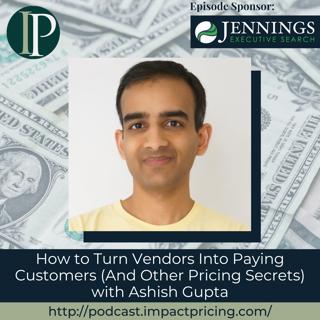
Blogcast: Everyone's Talking About AI. Almost Nobody's Using It.
This is an Impact Pricing Blog published on June 30, 2025, turned into an audio podcast so you can listen on the go. Read Full Article Here: https://impactpricing.com/blog/everyones-talking-about-ai-almost-nobodys-using-it/ If you have any feedback, definitely send it. You can reach us at mark@impactpricing.com. Now, go make an impact. Connect with Mark Stiving: Email: mark@impactpricing.com LinkedIn: https://www.linkedin.com/in/stiving/
5 Sep 4min

AI SEO and the Future of Brand Discovery with Bryan Phelps
Bryan Phelps is the founder and CEO of Big Leap, a digital marketing agency he's been running for 17 years. He's been working in digital marketing and SEO since college and recently served as a juror in a murder trial (though we don't discuss that). Bryan specializes in helping B2B tech companies and professional services firms navigate the evolving landscape of AI-powered search and discovery. In this episode, Bryan reveals how AI is fundamentally changing SEO and digital marketing, why traditional performance marketing tactics are becoming less effective, and how companies can build "brand-led performance marketing" strategies that work across Google, AI platforms, and future technologies. Why you have to check out today's podcast: Learn the key differences between B2B and B2C buyer behavior in the age of AI search. Discover the three pillars of AI SEO and how they relate to traditional search optimization. Understand why building relationships with the 95% of non-shopping audiences creates pricing power. "A lot of value is created before you ever start a pricing conversation. So that's how we're trying to help our clients shift a bit is, not just focus on that 5% of people that are in market and then compete on price." – Bryan Phelps Topics Covered: 01:40 – B2B vs B2C SEO differences: How buyer journeys vary from research-heavy B2B to purchase-ready B2C audiences 04:08 – AI SEO and discoverability strategies: Understanding where audiences search and optimizing for multiple platforms beyond Google 07:44 – AI recommendations and SEO strategy overlap: How AI's "query fan out" method connects Google rankings to AI search results 12:18 – Brand element and popularity component: Why being recognized as an industry authority matters more than broad household recognition 15:05 – Brand-led performance marketing shift: Moving from link-based to mention-based strategies in the post-tracking world 18:45 – Brand ideology and differentiation process: How to define unique viewpoints and align with genuine audience connections 20:22 – AI's impact on content creation: Why long-tail content is losing value and expertise-based content is gaining importance 25:56 – Pricing advice for businesses: Building value with non-shopping audiences to reduce price sensitivity and competition 27:02 – Staying informed in marketing: Bryan's LinkedIn newsletter for non-marketers navigating industry changes Key Takeaways: "The exciting thing for us is I think it's kind of going back to almost like pre Google. So it really is more of a brand marketing function in a lot of ways." – Bryan Phelps "Being known to your audience is ultimately what matters. You don't have to be the household name, necessarily, but if your audience is just a little bit more niche and specific, you can be the brand in their world." – Bryan Phelps "Our goal isn't to take any company and just try to cover the broadest of brands... we're trying to ultimately create a brand that aligns with our ideal client." – Bryan Phelps "Our goal is to help brands be remembered, not just discovered." – Bryan Phelps Resources and People Mentioned: Big Leap Digital Marketing Agency: https://bigleap.com Kobe Bush: Team member who coined "people notice different" concept Query Fan Out: AI method of breaking prompts into multiple searches Brand Ideology Process: Big Leap's framework for unique positioning Zero Click Marketing: New measurement paradigm for AI-driven discovery Connect with Bryan Phelps: LinkedIn: https://www.linkedin.com/in/bryanphelps/ Website: https://bigleap.com Connect with Mark Stiving: LinkedIn: https://www.linkedin.com/in/stiving/ Email: mark@impactpricing.com
1 Sep 27min

Blogcast: Product-Market Fit Is Overrated for Pricing
This is an Impact Pricing Blog published on June 30, 2025, turned into an audio podcast so you can listen on the go. Read Full Article Here: https://impactpricing.com/blog/product-market-fit-is-overrated-for-pricing/ If you have any feedback, definitely send it. You can reach us at mark@impactpricing.com. Now, go make an impact. Connect with Mark Stiving: Email: mark@impactpricing.com LinkedIn: https://www.linkedin.com/in/stiving/
29 Aug 5min

Why Pricing Deserves a Seat at the CEO Table with John Norkus
John Norkus is the founder of chiefpricingofficer.com and has led pricing transformation teams at several large consulting companies including Deloitte and KPMG. He started his career as an aircraft engineer before transitioning into business, bringing his analytical mindset to understanding the behavioral economics of pricing decisions. In this episode, John makes a compelling case for why pricing professionals deserve a seat at the executive table, exploring the disconnect between pricing's impact on enterprise value and its typical organizational placement. He discusses his new platform designed to unite senior pricing professionals and elevate the discipline to C-suite recognition. Why you have to check out today's podcast: Discover why pricing professionals are typically buried 2-3 levels below the CEO despite controlling one of four key profit drivers. Learn the difference between traditional pricing roles and true chief pricing officer responsibilities. Understand how to position pricing as enterprise value creation rather than just cost management. "Pricing may be part marketing, part analytics, part behavioral, part external, part internal, but it is the piece that aligns us on how we're actually squaring off against the market." – John Norkus Topics Covered: 01:43 – John's journey to pricing transformation: From aircraft engineer to behavioral economics and CRM to pricing strategy 05:18 – Positioning pricing as organizational connective tissue: Why pricing deserves equal footing with volume, cost, and mix initiatives 08:01 – The pricing control dilemma among departments: How sales, marketing, finance, and operations all claim ownership of pricing decisions 12:24 – Defining the Chief Pricing Officer's role: Executive alignment versus operational pricing work and transformation implementation 15:45 – Pricing strategies in business: Inside-out versus outside-in approaches and competitive intelligence versus customer willingness to pay 16:32 – Critical senior alignment in pricing projects: Why CEO buy-in as a top-3 initiative determines transformation success or failure 19:39 – Pricing and enterprise value analysis: Demonstrating 2-7% bottom-line impact within 12-18 months to justify executive investment 23:35 – The activist CFO and enterprise value: Finding CFOs who understand value creation beyond cost reduction and margin improvement 29:29 – Pricing as organizational alignment: How pricing serves as the ultimate test of market positioning and competitive strategy Key Takeaways: "If the pricing transformation of the pricing program isn't number one on the CEO's list of one, two, or three most important thing they can do this year... then quite frankly, it's not as important and it doesn't have the kind of alignment that you thought it did." – John Norkus "Organizations who get it are the ones that we should be engaging with... change comes from within. And if somebody believes that this is the right thing to do and they just need somebody to help them do it and somebody who has done it before, that's where people like you and I actually succeed." – John Norkus "I consider 20% of everything we do in pricing to be analytics or data and objective based, and the other 80% to be about behaviors, either internal behaviors or external behaviors that need to be captured and understood." – John Norkus People / Resources Mentioned: Professional Pricing Society (PPS): Established organization for pricing professionals and education Simon Sinek Four Drivers of Enterprise Profit: Volume, Cost, Mix, and Price - and their typical organizational reporting structures Connect with John Norkus: LinkedIn: https://www.linkedin.com/in/johnmnorkus/ Email: john@chiefpricingofficer.com Website: https://www.chiefpricingofficer.com/ Connect with Mark Stiving: LinkedIn: https://www.linkedin.com/in/stiving/ Email: mark@impactpricing.com
25 Aug 31min

Blogcast: When Pricing Becomes Sleazy Manipulation
This is an Impact Pricing Blog published on June 23, 2025, turned into an audio podcast so you can listen on the go. Read Full Article Here: https://impactpricing.com/blog/when-pricing-becomes-sleazy-manipulation/ If you have any feedback, definitely send it. You can reach us at mark@impactpricing.com. Now, go make an impact. Connect with Mark Stiving: Email: mark@impactpricing.com LinkedIn: https://www.linkedin.com/in/stiving/
22 Aug 6min

How Many Agents Should Pricing Software Have? with Steven Forth
Steven Forth is the founder and CEO of Ibbaka and by far Impact Pricing's most frequent guest. He's currently developing ValueIQ, a set of agents for pricing and value advisory work that will soon be available for broader use. In this episode, Steven discusses his recent research comparing agent strategies across four major pricing software companies, explores the fundamental question of how many agents is optimal, and reveals how AI is transforming both the buying and selling process in ways most companies aren't prepared for. Why you have to check out today's podcast: Learn how the four major pricing software companies (Pros, Vendavo, Zilliant, PriceFX) approach agent development differently. Discover the key difference between role-based and task-based agent design strategies. Understand how AI will fundamentally change B2B buying processes and what that means for pricing. "Start using AI to get a deeper understanding of how your customers are buying. Because if you don't understand how your customers are buying and buying using AI, you're not going to be able to price properly." – Steven Forth Topics Covered: 02:07 – ValueIQ introduction: Steven's new agent platform for pricing and value advisory work 06:34 – Defining agents: The difference between true agentic AI and wrapped LLM functionality 10:49 – Sales agent complexity: Breaking down the many tasks salespeople perform and agent granularity 12:35 – Pricing agents vs. features: How to decide between individual pricing and bundling strategies 15:55 – The future of pricing models: Why "good, better, best" packaging may disappear in 2-3 years 21:05 – AI's role in B2B buying: How AI intermediaries will transform RFP processes and vendor selection 25:06 – Understanding AI-powered customers: Why companies must learn how their buyers use AI in purchasing decisions Key Takeaways: "When I saw that PriceFX announced that it had more than 125 agents... I thought, huh, that's kind of a jaw-dropping number. I don't think I could generate 125 agents for pricing software." – Steven Forth "The role of AI in the buying process is more important than the role of AI in the sales process." – Steven Forth "You're going to be creating more content, not less. But that content is primarily going to be consumed by AIs." – Steven Forth "I think that many of the common packaging assumptions such as good, better, best are going to dissolve away over the next two or three years." – Steven Forth Resources Mentioned: Michael Mansard's 14-factor model: https://www.linkedin.com/in/michaelmansard/ Connect with Steven Forth: LinkedIn: https://www.linkedin.com/in/stevenforth/ Email: steven@ibbaka.com Connect with Mark Stiving: LinkedIn: https://www.linkedin.com/in/stiving/ Email: mark@impactpricing.com
18 Aug 27min

Blogcast: The Secret Link Between Market Segments and the "Will I" Decision
This is an Impact Pricing Blog published on June 16, 2025, turned into an audio podcast so you can listen on the go. Read Full Article Here: https://impactpricing.com/blog/the-secret-link-between-market-segments-and-the-will-i-decision/ If you have any feedback, definitely send it. You can reach us at mark@impactpricing.com. Now, go make an impact. Connect with Mark Stiving: Email: mark@impactpricing.com LinkedIn: https://www.linkedin.com/in/stiving/
15 Aug 5min

How to Turn Vendors Into Paying Customers (And Other Pricing Secrets) with Ashish Gupta
Ashish Gupta, founder and CEO of ScaleUp Exec, brings a unique perspective to pricing from his experience building and selling multiple companies across technology, e-commerce, and subscription businesses. Starting his career at Anheuser-Busch (as the company's only non-drinker), Ashish has led businesses from startup to eight-figure valuations, giving him deep insights into pricing across different business models and growth stages. In this episode, Ashish shares unconventional pricing strategies that transformed his businesses, including how he convinced vendors to provide products for free by repositioning his company as a marketing partner rather than a traditional retailer. Why you have to check out today's podcast: Discover how to identify and target the specific customer segments willing to pay premium prices for your unique value proposition. Learn the "influencer plus" strategy that transforms vendor relationships from cost centers into revenue-generating partnerships. Understand how subscription businesses create deeper customer relationships and the pricing implications of holding customer credit cards. "Instead of trying to go to a general audience, which may or may not be interested in paying you more for something unique about your product, really try and understand who is that core set of people that will find real value and be willing to pay for that value." – Ashish Gupta Topics Covered: 01:48 — Ashish's entrepreneurial journey: From Anheuser-Busch to multiple successful exits. 03:42 — The psychology of subscription pricing: Why holding credit cards creates deeper customer relationships. 07:54 — Win, Keep, Grow framework: The often-overlooked "grow" component in subscription businesses. 11:03 — ScaleUp Exec's fractional COO model: Bringing enterprise talent to small and medium businesses. 13:45 — Revenue growth strategies: How COOs approach customer acquisition and diversification differently. 17:34 — The pricing audit revelation: Why PE firms consistently find underpriced acquisitions. 22:01 — The "off balance sheet CFO" positioning strategy for premium pricing. 22:58 — The vendor flip strategy: From paying wholesale to getting products for free. 24:04 — Building the "influencer plus" model: Combining audience and distribution for vendor value. Key Takeaways: "I think relationship and subscription are, they kind of go hand in hand. That means I have to always be getting value. I have to have this confidence that, if somebody has my credit card and I've given them authorization to charge it versus like, let's say an Amazon, I'm proactively going in and saying, yes, I want this item." – Ashish Gupta "If we can build out our own audience, and grow that audience to be something meaningful and have a deep connection with that audience so that they really trust us, our brand as a retailer, then we can actually talk with our vendors and say, hey, we're no longer a retailer, we're really a marketing company." – Ashish Gupta Resources and People Mentioned: Anheuser-Busch: https://www.anheuser-busch.com Shopify Shop Pay: https://www.shopify.com/shop-pay PayPal: https://www.paypal.com/ Mark Stiving's book: "Win, Keep, Grow" about subscription businesses Connect with Ashish Gupta: Website: https://scaleupexec.com/ Linkedin: https://www.linkedin.com/in/ashish-gup/ Connect with Mark Stiving: LinkedIn: https://www.linkedin.com/in/stiving/ Email: mark@impactpricing.com
11 Aug 28min






















